ALICE LENSHINA MULENGA: “HERO” or “VILLAIN” ?
INTRODUCTION
“Hero or Villain”, sometimes history is told in a way that tries to classify people as either a “hero” or a “villain. However life is not that simple, a hero to some is a villain to others and a villain to some is a hero to others. Such is the legacy of one of the most important figures in Zambian history, Alice ‘Lenshina’ Mulenga. To some she was an inspirational figure who challenged the status quo and created a new path away from the powerful religious, social and political authorities of the mid 20th century. To others, she was a cult leader who was leading her fanatical followers astray and her fall was necessary in order to achieve the birthing of an independent Zambia in 1964. Regardless of which angle you view her legacy from, whether “hero” or “villain”, her story will forever be engraved in Zambia’s history and it is worth telling.
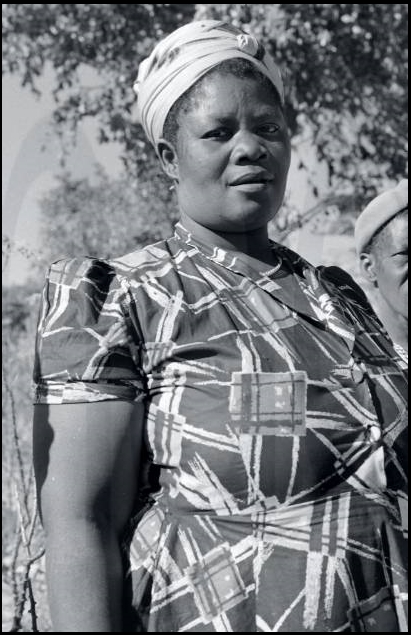
ALICE’S EARLY LIFE
Alice Mulenga Lubusha was born in the early 1920s in Kasomo village located near Chinsali in Northern Rhodesia (Present day Zambia). She came to be known as “Lenshina” which was the Bemba form of the Latin word “Regina”. Her home village of Kasomo was located about nine kilometers away from Lubwa Mission which was run by the Church of Scotland. In her early life, Alice was a member of the Church of Scotland. Her first marriage was to Gibson Nkwale who passed away. Following the death of Gibson, as per tradition Alice was cleansed and got married to Petros Chintankwa with whom she would have five children.
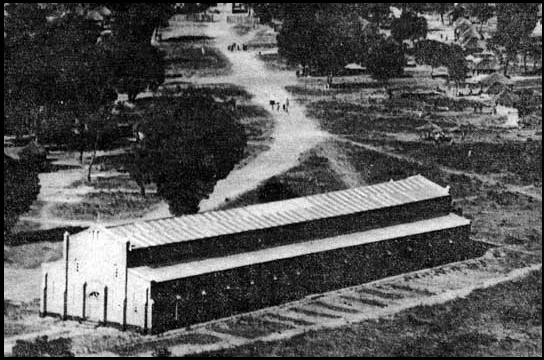
ALICE’S “DEATH AND RESURRECTION”
The year 1953 was an important year in Alice’s life. One morning in 1953, she was found in a deep coma, it was believed that she was suffering from an attack of cerebral malaria. The people of the village made a conclusion that she had died and they proceeded to make preparations for her burial. To everyone’s surprise, Alice whom they presumed dead began to regain consciousness and she “came back to life”. It was during this period of her alleged “death and resurrection” that she underwent her religious transformation.
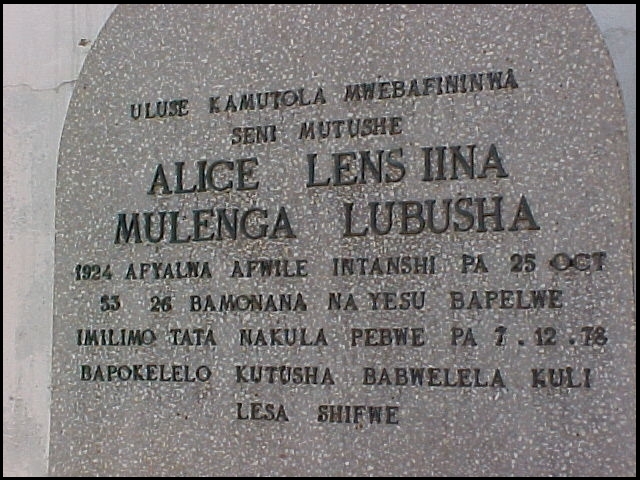
THE RISE OF ALICE LENSHINA MULENGA
When Alice Lenshina Mulenga “came back to life”, she narrated what she had experienced. Her account was that when she died, she found herself at a river where she says she met Jesus Christ who told her to go back to the land of the living because her time had not yet come. She said that before sending her back to earth, Jesus had taught her some hymns and shown her the book of life. She said Jesus had given her a mission and that he would frequently communicate with her to give instructions on how to further this mission.
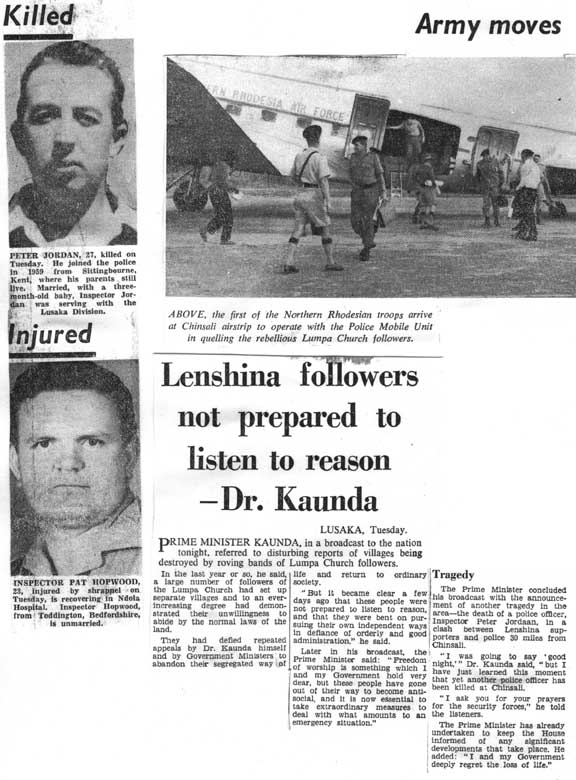
In the weeks and months after Lenshina’s “resurrection”, the news of the “miracle” began circulating. Filled with curiosity, small crowds in Kasomo village began to gather around Lenshina to hear her speak. She told the people messages which she said had come from Jesus Christ as she claimed to be in direct communication with Jesus, from whom she got her preaching. The preaching was usually accompanied by the songs she said Jesus had taught her.
Initially the relationship between Lubwa Mission and Lenshina was friendly. The Church leaders at Lubwa felt it was important to keep Lenshina and her followers within the church and so she was re-baptized into the Church of Scotland and continued as a member of the Church of Scotland.
However, as time went on, the relationship between Lubwa Mission and Lenshina gradually deteriorated when it became evident that she was moving towards the formation of a separatist church which had its own teachings, many of which were inconsistent with the teachings at Lubwa Mission. One of the issues which really raised concern among the church leaders at Lubwa were the reports that she was re-baptizing her followers (people who had already been baptized by the Missionaries at Lubwa or by the Catholics, or had been suspended by them).
By the end of 1955, the Lubwa Church elders expelled Alice Lenshina Mulenga and her closest followers from the Church. Following this, Alice Lenshina Mulenga decided to form her own independent church.
THE GROWTH OF THE LUMPA CHURCH
Alice’s church was different from the established churches, it promoted a blend between Christianity and traditional practices, and it also emphasized the role of women in the church. Alice’s new church was called the Lumpa church and it had its headquarters at Sione (Zion) in Kasomo village. The word ‘Lumpa’ was derived from the Bemba language and it meant “exceeding all the rest / be superior”. As time went on, the Lumpa Church began to live up to the meaning of its name and started to exceed the rest of the churches in terms of the speed with which it was growing.
One of the reasons that made Alice’s movement grow was that she preached about the need to eradicate the use of witchcraft. Without fear, she directly confronted those practicing witchcraft. She insisted that those wishing to be baptized should surrender to her any witchcraft materials that they had, as part of the process of their purification. Plenty of people began to come forward to surrender their witchcraft materials at Kasomo village and Alice would gather these materials and destroy them. The people, many of whom had lived in fear of witchcraft were now convinced that Lenshina had provided a solution for dealing witchcraft and this made a lot more people flock to her. Rumors even began to spread that anybody who was unwilling to go to Kasomo village for baptism, and cleansing from the powers of witchcraft was an unrepentant witch or wizard, and so to avoid this label many people found themselves going to Alice Lenshina for baptism.
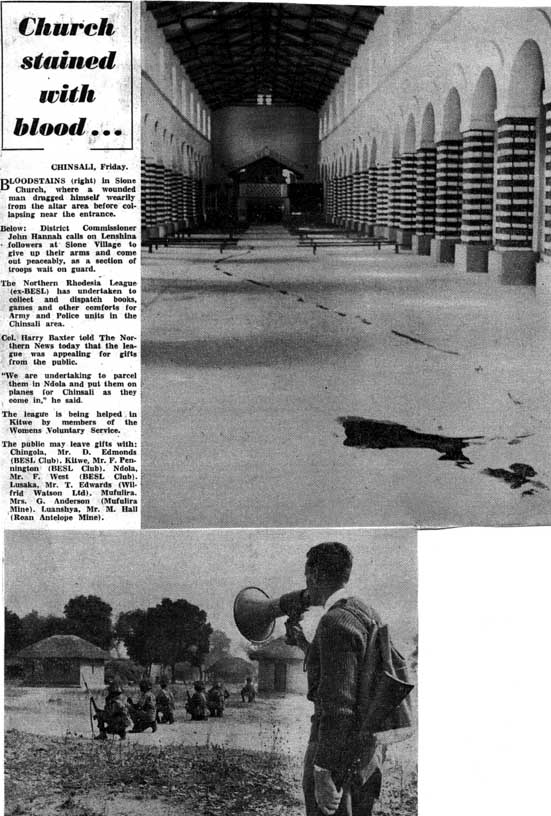
Alice Lenshina preached against foreign-run churches. Through her preaching she shattered the illusions of some Africans who thought that salvation could only be found in a foreign-run church. With time many people began to find the idea of a church that was indigenous very appealing, they believed the Lumpa church offered the African people religious independence from the white-run churches.
Both the Catholic Church and Church of Scotland missions within the area were shocked to see how many of their members began defecting to the Lumpa Church. The Lumpa Church which started among the Bemba of Chinsali had begun to transcend cultural boundaries by drawing converts from different churches and tribes in many parts of the country.
The Lumpa Church soon spread to most parts of Northern Rhodesia areas including Kasama, Isoka, Mporokoso, Kawambwa, Lundazi, Fort Jameson (Chipata), Lusaka, Broken Hill (Kabwe), Mpika, Abercorn (Mbala) districts and Luapula Province as well as all towns on the Copperbelt. The influence of the Lumpa even began to felt in neighboring countries like Congo, Nyasaland (Malawi), Tanganyika (Tanzania) and Southern Rhodesia (Zimbabwe).
Pilgrims began to flock from all over going to Chinsali where the Lumpa Church had erected a massive church building. Alice’s ability to heal people, her ability to catch witches/ wizards as well as the way she put Africans at the centre of running the church made the Lumpa church the place where everyone flocked to. The Lumpa church began to be the most vocal group in the area opposing colonial authority and white missionaries, especially the Catholics. In 1958, Lenshina and her followers had built her Zion (or Sione), a large Church situated next to Kasomo Village, Chinsali District. At its peak, the Lumpa church had over 150,000 members.
THE LUMPA CHURCH VERSUS THE POLITICAL ESTABLISHMENT
One of the doctrines of the Lumpa Church was to reject earthly authority. The only ultimate authority they recognized was Jesus Christ who they believed spoke through Alice Lenshina. They decided to stop paying government taxes. This defiance resulted in conflict with the chiefs and the colonial government who were the political authority of the day. Acts such as Lenshina’s refusal in 1959 to register the Church under the provisions of the Societies Act was also a sign of this defiance of earthly authority.
Another example of the defiance of earthly authority is when Lumpa followers started to disregard the tradition of getting permission from the chief before settling in an area and large numbers of them settled at Kasomo village without permission from the local chief. Angered by this disrespect, Chief Nkula sent his court messengers to evict these settlers from his chiefdom, unfortunately the messengers were defied by the Lumpa followers . The district commissioner gave Lenshina an ultimatum to remove these settlers and when his ultimatum was ignored, a Northern Rhodesian Police Unit was sent in and the police unit was confronted by Lumpa followers wielding stones and spears. The police managed to arrest some Lumpa followers and evict some of the followers. This incident was just a small indication of the conflict that had begun to brew.
The Lumpa church’s non-recognition of earthy authority also created conflict between them and UNIP (The United National Independence Party) which wanted everyone to cooperate in the fight for national political independence. As the 1962 elections drew closer, UNIP increased its pressure to gain as many followers as possible. UNIP wanted to ensure undivided loyalty and any organization that didn’t offer this loyalty was seen as a threat.
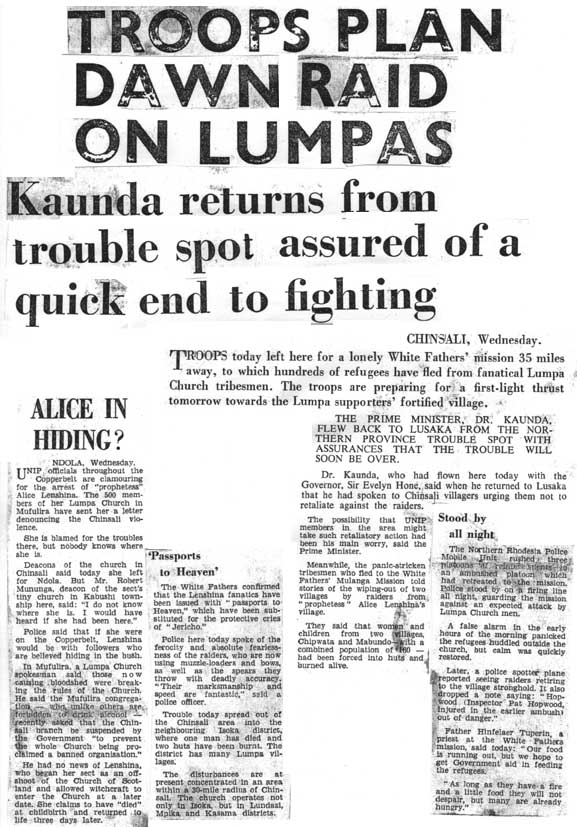
With the elections resulting in a UNIP-ANC coalition, the Lumpa Church felt increasingly isolated and it was now seen as the only mass movement that wasn’t on board with the struggle for national independence. In the eyes of UNIP members, the Lumpa Church was now becoming an obstacle to national independence. Kaunda and other leaders held meetings with the leadership of the Lumpa church to try and get the Lumpa church to unite with other political parties in the push for national independence. However the Lumpa church declined this union, and continued their principal of distancing themselves from politics and politicians.
Lenshina continued to preach that one could not be a member of UNIP and at the same time a Christian. To demonstrate their defiance of UNIP, some Lumpa church members burnt their UNIP party cards. In return some UNIP militants burnt down some Lumpa churches. This burning of churches was also met with revenge attacks from Lumpa followers. By 1963, both sides had started to become more and more aggressive with each other. UNIP followers throughout the Province started going round demanding party cards and intimidating those who did not possess them. These acts of intimidation by UNIP supporters were in most instances met with push back from Lumpa supporters were also firmly committed to their cause.
VIOLENT CONFRONTATIONS BETWEEN UNIP SUPPORTERS AND THE LUMPA CHURCH
Lumpa followers continued to complain of intimidation by UNIP followers, and towards the end of that year Lumpa followers gathered themselves and started creating new settlements in Chinsali District away from where UNIP members lived. The Lumpa members intended to live on their own, isolated from Government activities and the rest of the community. While the Lumpa followers claimed these moves were for their own greater safety, so that they could practice their religion without interference, many UNIP followers saw this separatism as an escalation of defiance and it created suspicion about what exactly the motives of the Lumpa members were.
Throughout 1963, there was still tension between UNIP followers and members of the Lumpa Church. There was still distrust between Lumpa members and UNIP members. UNIP members leveled allegations that they suspected that the Lumpa Church was working with Roy Welensksy to sabotage the independence push.
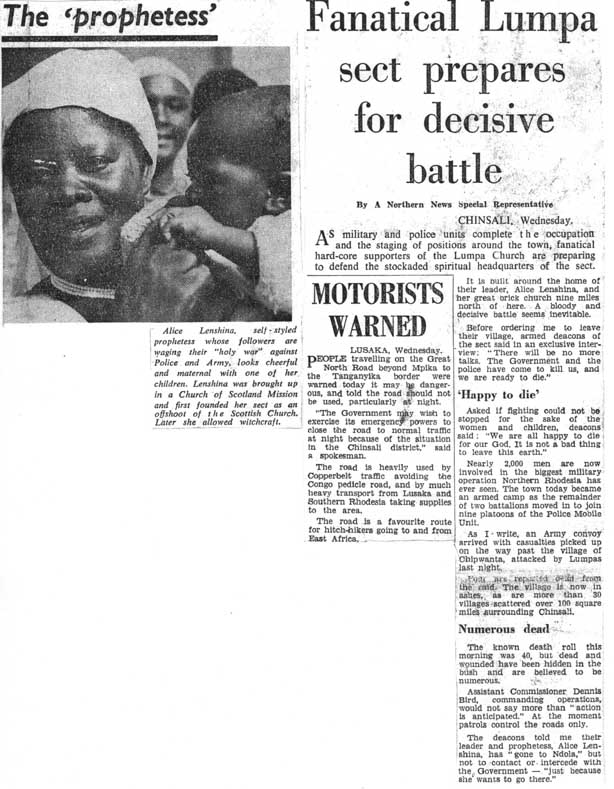
By November 1963, many Lumpa followers had left UNIP dominated villages and built their own barricaded villages without the permission from chiefs. They did this after what they said were constant attacks from UNIP members. At the end of December 1963, several battles between UNIP and Lumpa members broke out in Chinsali. There were guns and spears used by both sides. Many clashes occurred and many were killed and injured.
In due course, more and more Lumpa followers began to establish separate villages with fortifications around them. To them, it was a way to try and evade UNIP violence and isolate themselves. But to UNIP members, this creation of fortified villages by LUMPA members was seen as dangerous separatism.
In December 1963, following some violent incidents between UNIP and LUMPA members, Kenneth Kaunda visited Chinsali to participate in talks between UNIP and Lumpa local leaders. UNIP instructed their branches to be tolerant to the Lumpa followers. They also told Lumpa followers to abandon their newly established villages and return to their old villages. Although the LUMPA followers had initially agreed to do so, there were no signs of the Lumpa followers returning to their old villages; instead they consolidated their huts and gardens in the new settlements and were clearly determined to stay.
The deadlock continued until June 1964 when more deadly violence between UNIP and Lumpa followers occurred. Kenneth Kaunda, now Prime Minister, flew to Chinsali on 13th July 1964 and informed Alice Lenshina and her deacons of the Government’s decision that all Lumpa ‘illegal’ settlements were to be vacated within one week and the inhabitants were to return to their original villages. Kaunda insisted that this was non-negotiable and that within a week all the unauthorized Lumpa villages would be destroyed.
THE LUMPA UPRISING
The Lumpa villagers vowed not to move, they barricaded themselves in their settlements in view of the impending violence from the government and prayed to God to give them strength in the battle. On 15 July 1964, some government officials in the company of armed police officers tried to convince Lumpa members to return to their original villages but the Lumpa members refused.
The tensions began to rise, The deadline of 19th July 1964 had come and gone and the Lumpa followers had not moved. More violence irrupted as Lumpa followers attacked a UNIP stronghold and killed some UNIP members, there were also reports that some villages had been burnt. In another part of Chinsali, Lumpa followers speared two police officers. In an attempt to get those bodies, police units attacked the village and resulted in the death of many Lumpa followers. Following the police action, many Lumpa followers took to the bush and made reprisal raids on neighboring villages, burning and killing. As people began dying on both sides, the violence kept on escalating. There were clashes between Lumpa followers and Police.
The “Lumpa Uprising” was in full swing and the police was having trouble trying to contain the situation. Because of this, the decision was taken to deploy the army.
THE ATTACK ON SIONE (ZION) AND ITS AFTERMATH
Two infantry battalions camped in Chinsali getting ready to enter the Lumpa villages with full force. The Lumpa villagers had decided to defend their villages and their church. They were armed with spears, bows and arrows and a few homemade guns. At 08;40 on 30th July, the army made its move. When they arrived they gave chance for the District Commissioner to address the people and ask them to lay down their arms. The DC spoke through a megaphone saying if the villagers wanted peace they had to obey government instructions and come forward to surrender. The Lumpa villagers’ reaction was to defend their homes, they launched an attack on the troops, and the soldiers also charged firing with rifles and machine guns. Several Lumpa members were killed and injured, with only a few soldiers injured. The battle was over by 10;05. It was a massacre, the Lumpa members stood no chance against the fire power of the soldiers. The dead bodies of Lumpa villagers were littered all over the place.
Alice Lenshina herself had managed to escape the massacre at Sione (Zion). Following the attack of Sione, the soldiers continued to carry out operations in the Lumpa villages. They launched a hunt to capture Alice Lenshina. On 11th August 1964, Alice finally surrendered in Kasama District. She was given a guarantee regarding her own safety but warned that she might have to face criminal charges; she was flown to Ndola and then to Mumbwa where she was placed in detention.
Meanwhile in Lundazi, news of the attack on Sione had reached the Lumpa followers who were based in Lundazi. They abandoned their settlements and went into the bush. In an act of revenge for the Sione massacre, they went wild with rage attacking several villages resulting in several deaths. Hundreds of Lumpa villagers went on rampage attacking the Lundazi boma, attacking a police station, grabbing arms and killing people. Soldiers were airlifted into Lundazi from Chinsali to try and confront the Lumpa followers. A battle ranged between the soldiers and the Lumpa followers which resulted in the death and injury of many Lumpa followers. There was also a plan by the soldiers to go to a Lumpa village called “Paishuko” to disband that settlement; but this plan was put on hold.
However, on the next day, UNIP supporters launched an attack on the Lumpa village “Paishuko”, torturing and killing Lumpa followers in the most horrific ways. This attack was also met with revenge attacks from Lumpa followers.
In the view of the violence which had escalated, the Lumpa church was banned , It was decreed that any person who would present as a member of the Lumpa church or was found assisting a member of the Lumpa church would be prosecuted and face jail time. What had started as an operation to deal with Lumpa followers in Chinsali had now been extended to every region of the Lumpa church. In the weeks after the Sione attack , operations were launched against Lumpa villages as well as the roaming Lumpa villagers and refugees leading to several deaths. Many Lumpa followers died of starvation having abandoned their villages. In some districts like Isoka, the Lumpa villagers surrendered without resistance. By the beginning of September 1964, thousands of Lumpa followers were roaming in the bush or imprisoned .
By the end of the “Lumpa Uprising”, over 1,000 people had died from the clashes between Lumpa members, security forces and UNIP members. About 15,000 Lumpa church members fled and took refuge in Congo. In the eyes of many people, this large number of dead was seen as nothing but a massacre of villagers who had not capacity to fight on equal ground with trained soldiers.
ALICE AND THE LUMPA CHURCH AFTER 1964
Alice Lenshina never faced trial, but she was detained for 11 years by the government. Initially she was detained in Mumbwa and then moved to Kalabo district. On 24th October 1967, Alice Lenshina and her immediate family escaped from the detention camp in Kalabo, western province and fled towards Angola. The Zambian government fearing an invasion from the Lumpa church which was resurfacing in Mokambo, launched an operation to capture Alice Lenshina and prevent an attack from Congo. Angolan rebels captured Lenshina and handed her over to the Zambian government. After she was caught she was taken to Mukushi district where she was held.
In 1970, the government ordered the destruction of the Lumpa Kamutola church in her home village of Kasomo. The once glorious building was brought to the ground and reduced to nothing but ruins.
In December 1975, Alice Lenshina Mulenga was released from detention and put under house arrest in Lusaka. Alice Lenshina Mulenga died on 7th December 1978 in Lusaka while under house arrest and was eventually buried at Kasomo village where the Kamutola Church building had stood.
WHAT REMAINS OF THE LUMPA CHURCH ?
After the collapse of the Lumpa Church, the remnants of the banned Lumpa Church, reconstituted themselves as the Jerusalem Church after spending years of exile in the Democratic Republic of the Congo (DRC). To this day, supporters of the Lumpa Church hold the view that the destruction of the Lumpa Church movement and the massacre of its members is one of the greatest injustices that has ever befallen Zambia.
CONCLUSION
This episode in Zambian history raises questions as to whether some things could have been done different to prevent the clashes between UNIP members and Lumpa followers. Would negotiations have prevented the “Lumpa uprisings” and the “Lumpa massacre”?. The legacies of everyone involved will be left in the records of history for people to make their own judgments on this tragic ending of one of the most influential church movements Zambia has ever seen.
(By Zambian Footprints)